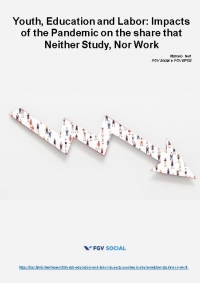
Youth, Education and Labor: Impacts of the Pandemic on the share that Neither Study, Nor Work
About the research:
What was the Impact of the Pandemic on the Work and Study of Youngsters?
Recent studies conducted by FGV Social show high vulnerability of the youngest Brazilians during times of crisis. These shocks can leave permanent stamps, the so-called scar effect, on the trajectory for an entire generation even after the crisis. In normal times youth is a time of ascension in the labor market. Based on this evidence, we have decided to take a special look into the impact of the pandemic on young people taking place both in their work and study.
Initially, we described, through the use of PNADC microdata, the evolution of the binomial education and work amongst young people (between 15 and 29 years of age), in particular, those who are out of occupation in the labor market and in educational institutions. These statistics, of the so-called “neither-nor (nem-nem)”, offer a useful alternative to describe the greatest challenges faced in this transitional phase from childhood to adulthood. The bad news is that with the arrival of 2019.4 (last quarter of 2019) the share of young people that neither study nor work which was at 23.66% accelerated, reaching a historical record of 29.33% in the second quarter 2020, before dropping to 25.52% by the last quarter of 2020.
The study points out in a timely manner, which is fundamental in the case of public policy reactions, especially during the pandemic, pronounced labor occupational losses for young people in the past year, greatly expanding on the magnitude seen in the last 6 years. Solely in the pandemic the rate of unemployment or inactivity in the 15 to 29 age group rose from 49.37% to 56.34% between 2019.4 and 2020.4. This is the dominant factor used in measures of young people’s use of time.
On the other hand, we measured a surprising decrease in the dropout rate during the pandemic, which is present in all youth groups, reaching its lowest measured level in 2020.4, with 57.95% percent of the 15 to 29 age group out of school, compared to 62.2% in 2019.4. The lack of job opportunities coupled with lowered substantive academic expectations due to no restrictions on attendance and automatic approval may explain the lower dropout rate. In any case, it is necessary to take advantage of the opportunity and, for example, promote digital inclusion and new remote educational content.
The study presents a series of maps that detail these changes between Brazillian states who bear several responsibilities in relation to problems that affect young people starting with public highschool and unemployment programs plus security and traffic policies among others.
Finally, it is necessary to look at the inverted image seen in the mirror of the “nem-nem”, also focusing on those who work and study both at their jobs and at home. It is also essential to incorporate gray tones in political proposals and their diagnosis. The extensions of both working and school hours determine performance on both of these fronts. Concerning actions, it is necessary to seek the conciliation between study and work by graduating parameters in order to meet the final policy objectives, namely de facto learning and job creation. Incentives for reduced youth labor seems desirable from both perspectives, enabling better quality of learning as well as socializing work positions in a larger group of people, with effects also seen on labor equity.
TEXTO E SLIDES
l Sumário Executivo
I Slides
I Mapas
% Nem Nem Variação (%)
% Evasão Escolar Variação (%)
% Desocupação Variação (%)
I Vídeos
Vídeo longo com slide (11min35s)
Vídeo Curto (2min)
| Contact: fgvsocial@fgv.br / +5521 3799-2320




